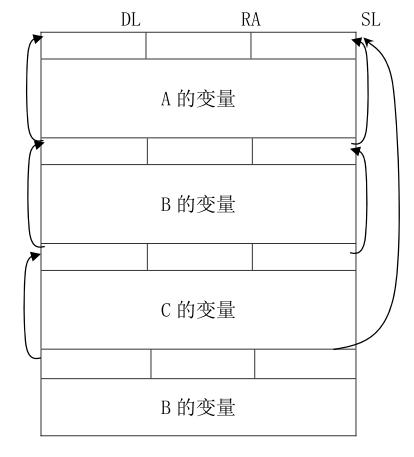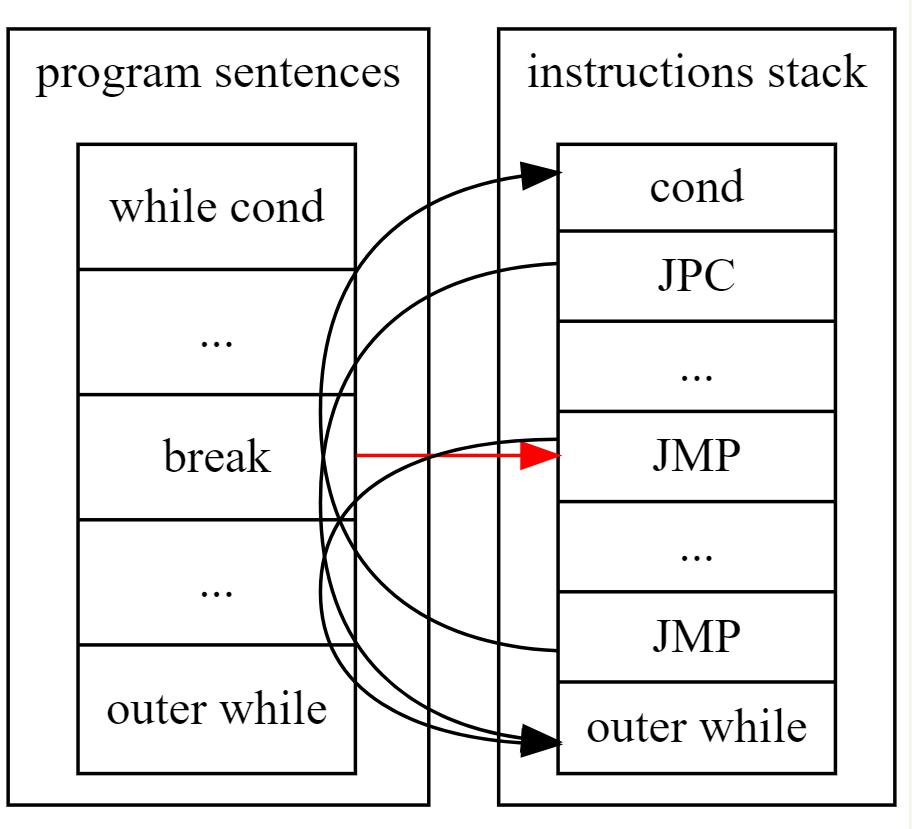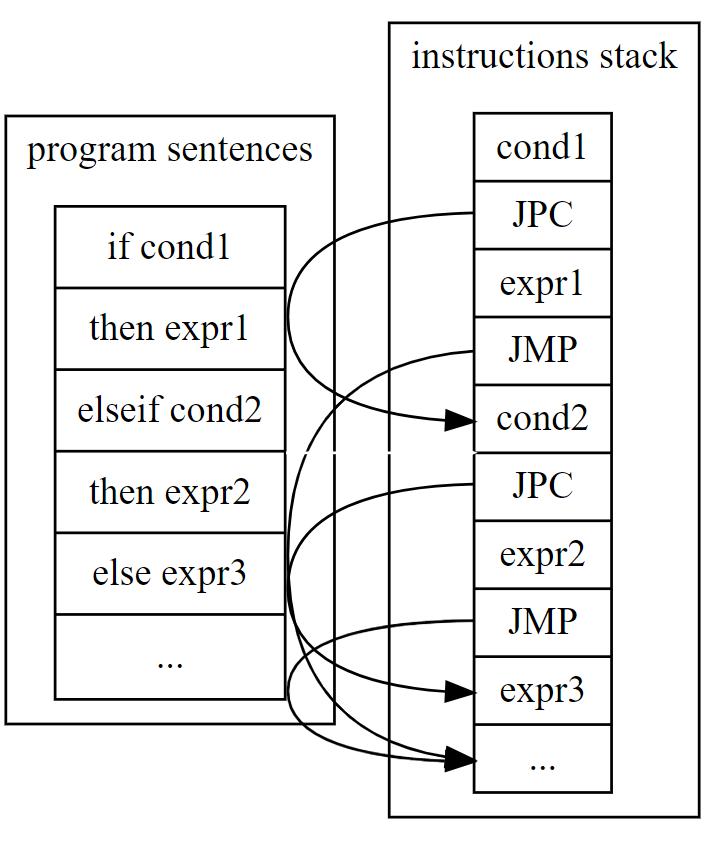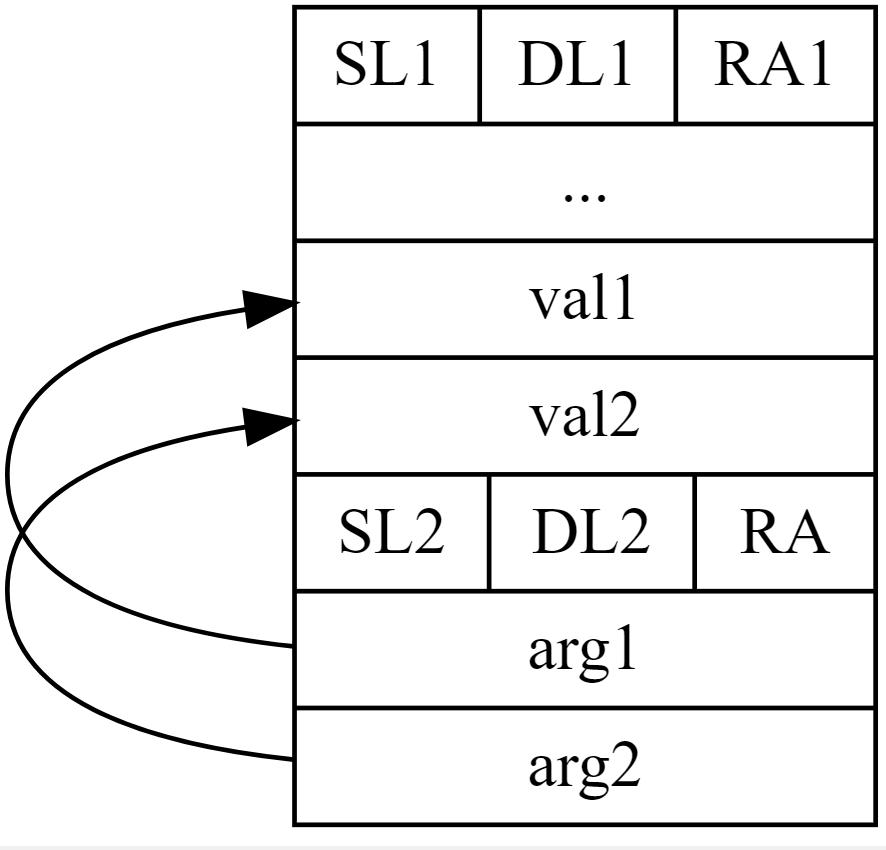| .. | ||
| src | ||
| test | ||
| parser.py | ||
| README.md | ||
| requirements.txt | ||
| token_scanner.py | ||
PL0-compiler
A compiler for c-like programming language based on PL0, which is a dynamic, strong typing language.
See grammar here, wikipedia-PL0, and download this pdf(zh) for more details.
QuickStart
usage: parser.py [-h] [-i] [-s] [-t] [-v] [-f FILE]
optional arguments:
-h, --help show this help message and exit
-i, --instruction output instructions
-s, --stack output data stack when executing each instruction
-t, --token output tokens when parsing
-v, --varible output varibles for every static environment
-f FILE, --file FILE compile and run codes. Without this arg, enter
interactive REPL
Run python parse.py and enter a REPL state, you can type and run sentences and expressions interactively
Examples
Note that when in REPL, every sentence or expresion or block ends with '.'. But in program codes, only the whole program ends with a dot.
interactive-expression
Therer are some expressions and sentence in file expr.txt, now test it.
python parser.py -f test/expr.txt
>> codes:
1 // expression
2 var a=3,b=2,c;.
>> c:=a+1.
>> begin c; c+1!=1 ; c+1=5 end.
result: 4.0; True; True;
>> for(;b>=0;b:=b-1) print('random(100): %d',random(100)) .
random(100): 14
random(100): 60
random(100): 58
>> begin ++1--1; 1<<2+3%2; 2&1 end.
result: 2.0; 8; 0;
>> -1+2*3/%2.
result: 2.0;
>> (1+2.
line 1: ( 1 + 2 .
^
[Error]: Expected ")", got "."
>> 4!!.
result: 620448401733239439360000;
>> codes:
1 if 0 then 1
2 elif 1>2 then 2
3 elif false then 3
4 else 4.
result: 4.0;
fibonacci
Run python parser.py -f test/fibonacci.txt
>> codes:
1 func fib(n)
2 begin
3 if n=1 || n=2 then return 1;
4 return fib(n-1)+fib(n-2);
5 end ;
6 var n=1;
7 begin
8 while n<15 do
9 begin
10 print('fib[%d]=%d',n,fib(n));
11 n :=n+1;
12 end;
13 end
14 .
fib[1]=1
fib[2]=1
fib[3]=2
fib[4]=3
fib[5]=5
fib[6]=8
fib[7]=13
fib[8]=21
fib[9]=34
fib[10]=55
fib[11]=89
fib[12]=144
fib[13]=233
fib[14]=377
Try the following commands to explore more examples.
python parser.py -f test/factorial.txt
python parser.py -f test/closure.txt
python parser.py -f test/closure.txt -i
python parser.py -f test/closure.txt -t
python parser.py -f test/closure.txt -s
python parser.py -f test/closure.txt -istv
python parser.py # enter interactive repl
Description
ident type
- constant
- varible
- function
operator
relation opr
- <
- >
- <=
- >=
- = equal
- !=
- odd
bit opr
- & bitand
- | bitor
- ~ bitnot
- << left shift
- >> right shift
arithmetic opr
- + add/plus
- - sub/minus
- * multiply
- / divide
- /% integer div
- % mod
- ^ power
- ! factorial
conditon opr
- ?: eg a>b ? c:d
control structure
- if elif else
- for
- while
- break
- continue
- return
builtin function
- print(formatStr,arg1,...)
- random(), random(n)
Grammar
program = body "."
body = {varDeclaration ";" | constDeclaration ";" | "func" ident "(" arg_list ")" body ";"} sentence
varDeclaration = "var" varIdent { "," varIdent}
varIdent = ident ["=" number] | ident { "[" number "]" }
constDeclaration = "const" ident "=" number {"," ident "=" number}
sentence = [ ident ":=" { ident ":=" } sentenceValue
| "begin" sentence { ";" sentence} "end"
| "if" sentenceValue "then" sentence {"elif" sentence} ["else" sentence]
| "while" sentenceValue "do" sentence
| "do" sentence "while" sentenceValue
| "switch" sentenceValue {"case" sentenceValue {"," sentenceValue} ":" [setenceValue]} (* ["default" ":" sentenceValue] to do *)
| "break"
| "continue"
| ["return"] sentenceValue
| "print" "(" str,real_arg_list ")" ]
sentenceValue = condition
arg_list = ident { "," ident}
real_arg_list = sentenceValue {"," sentenceValue }
condition = condition_or [ "?" sentenceValue ":" sentenceValue ]
condition_or = condition_and { "||" condition_or }
condition_and = condition_not { condition_not "&&" condition_and}
condition_not = {"!"} condition_unit
condiiton_unit = ["odd"] expression
| expression ("<" | ">" | "<=" | ">=" | "=" | "!=") expression
expression = level1 { ("<<"| ">>" | "&" | "|") level1 }
level1 = level2 { ( "+" | "-" ) level2 }
level2 = level3 { "*" | "/" | "/%" | "%" ) level3 }
level3 = level4 {"^" level4}
level4 = item {"!"} (* factorial *)
item = number|"true"|"false" | ident { "(" real_arg_list ")" }| "(" sentenceValue" )" | ("+" | "-" | "~" ) item
syntax
Writet down syntax, then convert left recursion to right recursion. Namely we should change the following productions: expr, level0, level, level3
We notice that
A -> Aa|b
equls to
A -> bR
R -> nil | aR
so here are the right-recursion productions
expr -> level1 interval1
interval1 -> nil | {&|'|'|>>|<<|} interval1
level1 -> level2 interval2
interval2 -> nli | {+|-} interval2
level2 -> level3 interval3
interval3 -> nil | {*|/|//|%} interval3
level3 -> level4 | level4 ^ level3
level4 -> item interval4
interval4 -> nil |! interval4
item -> NUM|E|PI|ln(expr)|(expr)| + item| - item| ~ item
When implementing the parser, we can use a loop structure to implement the right recursion because it's tail-recursive.
For instance, we can simply find that the production for level4 is
level4 -> item | item ! | item!! |item !!! | ...
Though we can't write a production with infinite loops, we can write it in code like this:
match_level4():
result = match(item)
while lookAhead matches item:
match("!")
result = factorial(item)
return result
Instruction generation
We designed several instructions that can be generated for the target machine. To simplify this problem, we will emulate this virtual machine and execute instructions in python.
register
This machine has three registers:
bis the base register that contains the base pointer to locate a varible in the data stackregsare a series of registers. Currently the first one is used for returning value of latest function call, and the second one is used to store theswitchvaluepcis the pc register that points to the instruction
stack
There are two stack in this virtual machine.
One contains the instructions, visited by register pc. It won't change when executing instructions, so we can assume it's readonly
The other is data stack. It dynamiclly changes when running the program.
For each level, the first is the base address of this level. The second place is the static chain to visit the upper level's varibles. The third place contains the return address of the upper level.
And the other places in one level contains local varibles and real time data for calculation.

Each time we call a function, the level increases 1. Also, the level decreases 1 when we return from a function.
instruction
Every instruction consists of three parts. The first is the name of the instruction. Generally, the second is the level diifference of a identifier(if it has). And the third part is the address.
| name | levelDiff | address | explanation |
|---|---|---|---|
| INT | 0 | n | allocate n space for one level |
| INT | 1 | n | rewind stk.top backward n steps |
| INT | 2 | n | print the top n elements of stack |
| LIT | - | constant value | push a constant value to the top of the data stack |
| LOD | levelDiff | addr | load a varible value to the top of the data stack. The var can be found use levelDiff and addr |
| STO | levelDiff | addr | store the stack top value to a varible, top decreases. |
| CAL | levelDiff | addr | call a function |
| JMP | - | addr | jmp to addr, namely set addr to pc |
| JPC | - | addr | pop stack, if the value is not True, jmp addr |
| MOV | n1 | n2 | stk[top-n2] = stk[top-n1] |
| RET | - | - | return to the upper level, use current level's first three value to change pc, data stack, base register. |
| POP | - | - | pop the data stack, store the value in reg register |
| PUSH | - | - | push reg to stack top |
| OPR | - | operator type | variout operation on value |
Design
We can generate instruction when analysing grammar. Some keypoints is the control structures' instruction traslation.
if elif else
while/break

continue, for can be translated in the same way.
switch
eg
switch n
case 1,2:print('1 or 2')
case 1+5:print('6')
case func_add(1,6):print('7')
;
function arguments pass
When analysing the function's defination, we can store the formal arguments as function's local varibles. As soon as we call this function, we should calculate the real arguments in the level upper the function, and then pass value to the function's formal varibles one by one.
I use an instruction MOV to achive this goal. MOV addr1, addr2 will store value stk[top-n2] in stk[top-n1].
Let's have a look at how to call a function and pass args value.
Before we call a function, its real args will be calculated in the level upper this function. Note function level is n+1, and we call this function in level n.
In level n, we calculated function's args, all values are stored in the data stack of level n. Now call function and enter it. Data stack reaches level n+1 and grows three spaces for DL,SL,RA. The following space are for function's local varibles. So we can mov level n's real args value to these places according to function's argument num and varible num.
For example, function has n1 args, n2 local varibles(excluding args), then
for i in [0,1..,n1-1]:
mov , n2+n1+3+i, n2 + i
The moment we returned level n, we should rewind top for n1 spaces, OPR,n1,'BACK' can make it.
function return
Also, mark function level as n+1, and outer(upper) is level n.
To implement return sentence, we just need to do two things:
- calculate
returnsentence value in level n+1 - pass this value to level n It seems that it's hard to pass level n+1 's value to level n. Once we returned to level n, level n+1 's data in data stack will be cleared.
I use a extra register reg to achive this. Before we return,
- calculate return value
OPR ,0,'POP'will pop the value and store it in reg- return level n
OPR,0,'PUSH'will push reg value to stack top
Now the return value has be passed from level n+1 to level n

instruction backpatching
Taking while block as an example, Note that we don't know the JPC instruction's target addr until we finish analysing the whole block.The Solution is that after we analyse while condition, we generate an instruction with no target address, just take a place. We note down this instruction's address. As soon as we finish analysing the whole while block, the instruction pointer, namely ip, pointing to the target address of JPC. Then we backpatch the JPC instruction with the target address along to ip.
symbol table
When analysing and translating, we want to get the symbol which including level, address,(value for constant) according to its name. The following shows how to achive it elegantly
There are three types of symbols:
- constant
- varible
- function name Every function has an environment that contains this level's symbols, and an outer environment(except main function). Every environment has the three symbols mentioned above.
Defaultly, we are in the main function in the beginning of this program.
In an enviroment, when we meet a symbol, we should seek it in current environment. If not found, go for the outer environment recursively until we found it.
It gurantees that every environment has no same names for different symbols but may have same names in different environment.
So there won't be conflits when different functions have same local varibles or arguments.
I create class closure to describe this kind of environment and varible curClosure to mark down current environment. Every time when calling a function, we enter a more inner environment. We do the following things to make sure that environment changes creately.
saved = curClosure
curClosure = function.closure
call function
curClosure = saved
builtin function--print
This function is just like function printf in clang.
Call it in the following format:
print(FORMAT[,arg1,arg2...])
The format string supports two kinds of format currently:
%d: integer%f: float
If you want to print raw %d, not formatting. You can add a back slash in front of %. (So it's with %f...)
For example:
>> print('a=%d, % \%d',1)
a=1, % %d
To implement this builtin function, we should firstly parse the formatting str. I parse the format-str and generate segs seperated by %d or %f.
For instance, 'fib[%d]=%d' generates segs ['fib[','%d',']=','%d'].
For every seg, if it's string, generate instruction ('LIT',0,c), c is one chracter that consist of seg.
If it's %d or %f, we should first match comma, and then parse the followwing value and generate instructions. When in runtime, after executing there instructions, we will get a value(only take place one data-stack unit).
After handling all segs, we generate an instruction ('INT',2,n), which represents printing the top n units of data stack, and stk.top = stk.top-n.
N can be calculated by suming all lengths of str-seg, and num of format-seg.
To do
- array
- different value pass
- function pass
- type
- struct






